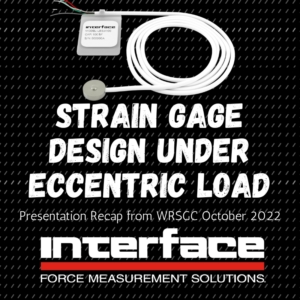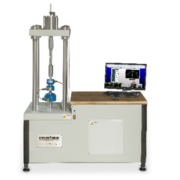Strain Gage Design Under Eccentric Load WRSGC Presentation
 By Ashlesa Mohapatra, product design engineer, Interface
By Ashlesa Mohapatra, product design engineer, Interface
In the global marketplace, Interface is well known as providing the force measurement industry’s most reliable and accurate products. One of the key reasons that Interface consistently earns this recognition is because we manufacture our own strain gages. Products engineered and manufactured at Interface use our proprietary strain gages, and each designed for the specific transducer model based on the application type and environment for use.
As an example of our dedication to quality and excellence in performance as it pertains to strain gages, I recently shared a technical presentation on the negative effects of eccentric load and how strain gage design can reduce these challenges.
 Below is a brief recap of this presentation made to the attendees of the Western Regional Strain Gage Committee meeting that took place in Tempe, Arizona in October 2022. The summary explains why strain gage design can make all the difference in quality versus poor performance with load cells.
Below is a brief recap of this presentation made to the attendees of the Western Regional Strain Gage Committee meeting that took place in Tempe, Arizona in October 2022. The summary explains why strain gage design can make all the difference in quality versus poor performance with load cells.
Interface redesigned the strain gages on one of our mini load cells, the LBSU Miniature Load Cell Load Button, also known as our ConvexBT – The Most Innovative Load Button Load Cell. Our goal in the redesign was to create more controlled and repeatable loading, in turn creating a more predictable output. Our research focused on strain gage designs for load cells where mechanical moment compensation is not feasible.
The main challenge with this initiative was overcoming the errors associated with eccentric loading by making the installation process smoother through a redesign. This is difficult because strain gages are very small in size and therefore more difficult to work with, in addition they are extremely sensitive to the environment with factors like temperature, humidity, cleanliness and electric interference all potentially effecting performance.
Before diving into the redesign, I would like to touch on eccentric loading and the errors it will cause, as well as the varied factors in strain gage manufacturing that can lead to errors causing eccentric load. There are two types of eccentricity: loading and mounting. Eccentric load results from improper loading or mounting of the strain gage, which leads to off-axis loads and bending. This causes several problems including distorted measurement results, decreased load cell accuracy, and diminishing life of the load cell.
When a strain gage is mounted on the load cell incorrectly or gages are badly bonded, it will almost always be an error source and contribute to mounting errors. Also, when strain gages are not bonded to the load cell at appropriate temperature and humidity, it leads to bubbles under the gage. Chemical composition of the strain gage is critical, such as the adhesive between the foil and backing, based on the application in which load cell will be used in a lab, machine, or testing program.
With these factors in mind, we set out on a redesign continuous improvement project. The previous design of this products strain gages was rectangular in shape. So, when the load cell was loaded, eccentrically or not, the strain field would not pass through because of shape. Therefore, we began to look at other shapes for our strain gage design, ultimately landing on a circular “diaphragm” style strain gage that allow strain fields to pass through.
One of the features of this newly designed strain gage is the proprietary adhesive foil we used to adhere the foil to the backing. This adhesive provided a great deal of benefit including a lower modulus of elasticity making it resilient to adhesive failure, and the elasticity also allows for better flow.
Another feature is the full bridge gage pattern we used that provides three key advantages. This includes fewer solder joints and reduced risk for electrical shorts due to simplified wiring, reduced symmetry error, and consistent thermal performance.
One process improvement we wanted to point out was that in our calibration process we only used 5V excitation voltage. Most manufacturers use 10V to calibrate their load cells. Due to lack of thermal mass in the thin diaphragm design of our strain gage, the zero will shift due to high voltage and low poor heat dissipation with 10V. We use a 5V excitation voltage to calibrate these miniature load cells instead of the alternative to prevent overheating of the cell.
To further improve the design, we enhanced the inspection process. Our diaphragm gages are quality inspected for accurate mounting with visual and electrical testing. Visual testing includes checking for air bubbles under the gage, badly bonded edges, unreliable solder connections and flux residues. Electrical tests include checking for electrical continuity and insulation resistance.
We then moved our attention to the circuit board. Some manufacturers use a circuit board in the cable due to the limited space within the cell to improve zero balance zero balance and to better compensate for temperature. However, bending or moving this cable would put pressure on the board and shift the zero. Therefore, we elected to install an abradable compensation resistors inside the flexure instead of the cable. This keeps the compensation resistor close to the gages and is intimately bonded to the body of the sensor to improve the reaction time of the cell to temperature.
To evaluate and confirm that our design was superior, we assessed three different strain gage styles: the rectangular gages (discreet gages), patch gages, and our diaphragm gage. Each of the gage styles were placed on three different load cells and loaded at one degree centricity. This test was run at 45 degree increments eight times. The results showed diaphragm style provided more reproducible result under eccentric load compared to other gages.
This was an interesting undertaking that taught the project team a lot about strain gage design and eccentric load. What I took away from this experience, other than a superior design for our ConvexBT Load Button Load Cells, is that any commercially successful product has a strong process behind it. You also need to have a clearly defined process that includes a continuous improvement plan. Interface Minis are a popular product line that has been around for many years. As soon as a product like this hits a point of stagnation, it will lose its hold on the market. I am proud of our team’s ability to avoid stagnation by taking critical steps to improving the Mini product line, maintaining our reputation for having the best quality, accurate and reliable products no matter the capacity available for precision force measurement.
 Western Regional Strain Gage Committee (WRSGC), a technical division of the national Society for Experimental Mechanics (SEM), was established to promote a free interchange of information about strain measurement techniques using strain gages.
Western Regional Strain Gage Committee (WRSGC), a technical division of the national Society for Experimental Mechanics (SEM), was established to promote a free interchange of information about strain measurement techniques using strain gages.
Interface is a proud member and sponsor of WRSGC. Our engineers participate in the technical conferences, in both presentation and attendance. Interface’s Product Design Engineer Ashlesa Mohapatra presented at the event held in Arizona, October 17-19, 2022.








